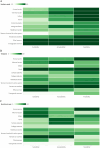Suitability, acceptability, feasibility of modern menstrual methods: a qualitative study in Coimbatore district, Tamil Nadu, India
- PMID: 39776786
- PMCID: PMC11703974
- DOI: 10.3389/fgwh.2024.1497686
Suitability, acceptability, feasibility of modern menstrual methods: a qualitative study in Coimbatore district, Tamil Nadu, India
Abstract
Objective: To examine women's perceptions of modern menstrual hygiene methods (MMHM), such as tampons and menstrual cups, focusing on socio-demographic variations and special groups in the Coimbatore district of Tamil Nadu.
Methods: A qualitative study among women of reproductive age (15-49 years) group was conducted using Focus Group Discussions (FGDs) among twelve women subgroups independently in 2023.
Results: The present study involved 23 focus group discussions (FGDs) across various groups of women, including those in formal and informal sectors, urban and rural areas, school and college students, healthcare workers, women in sports, tribal women, transgender women, and female sex workers (FSW), with a total of 188 participants. The age range varied across groups, from 15 to 45 years. Over half of the participants were married (51.1%), and 68.7% were literate, though illiteracy was higher in the informal sector, rural, tribal areas, transgender women, and FSW groups. Sanitary pads were the most used menstrual hygiene method (88.3%), followed by cloth (4.8%), and modern methods like menstrual cups or tampons (1.6%). Notably, 70% of FSW and 28.6% of tribal women still used cloths. Menstrual hygiene choices were often influenced by family recommendations, school-based menstrual hygiene sessions, institutional policies, and social media. Regarding satisfaction, 27.1% were content with their menstrual hygiene method, citing accessibility, affordability, and leakage prevention. However, issues with pads included heat, rashes, and discomfort. A significant number (31.4%) shifted from cloth to pads recently, mainly due to leakage and lack of adequate washing facilities. Only 6.1% had tried modern menstrual methods, with tampons and menstrual cups being considered more suitable but less feasible, especially among tribal women. Participant concerns ranged from the potential health risks of sanitary pads to waste disposal challenges. Recommendations included public menstrual hygiene management (MHM) dispensers, better waste collection practices, and increased awareness through advertisements. Some participants advocated for the concept of free menstruation, emphasizing informed choices and accessibility for all.
Conclusion: The findings suggest that increasing access to modern menstrual hygiene products, coupled with comprehensive education and support, could improve acceptance and feasibility, especially for marginalized and underrepresented women.
Keywords: India; acceptability; community based participatory research; feasibility; modern menstrual methods; suitability; women.
© 2024 Aparnavi, Ramanathan, Shanmugam, Narayanan, Kumar, Ramya, Rathinamoorthy and Vignesh.
Conflict of interest statement
The authors declare that the research was conducted in the absence of any commercial or financial relationships that could be construed as a potential conflict of interest.
Figures
References
-
- World Health Organization. Women of Reproductive age (15–49 Years) Population (thousands). (2024). Available online at: https://www.who.int/data/gho/indicator-metadata-registry/imr-details/wom... (cited September 4, 2024)
-
- UNICEF. Guidance on Menstrual Health and Hygiene. UNICEF; (2019). Available online at: https://www.unicef.org/documents/guidance-menstrual-health-and-hygiene (cited September 17, 2024)
-
- Mason L, Nyothach E, Alexander K, Odhiambo FO, Eleveld A, Vulule J, et al. ‘We keep it secret so no one should know’–a qualitative study to explore young schoolgirls attitudes and experiences with menstruation in rural Western Kenya. PLoS One. (2013) 8(11):e79132. 10.1371/journal.pone.0079132 - DOI - PMC - PubMed
LinkOut - more resources
Full Text Sources



